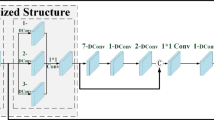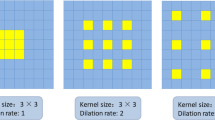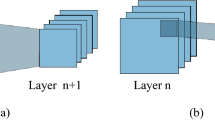Abstract
Image denoising is an important ill-posed problem of image processing. The main goal in image denoising is to suppress noise while protecting textures of the image. A plethora of methods and different approaches have targeted image denoising problem. In this manuscript, we propose a novel method which brings dense and residual blocks together with dilated convolutions in image denoising applications. The proposed method introduces new strategies for proper combination of dense residual blocks and dilated convolution layers. The resulting approach is called as Densely connected Dilated Residual Network (DDR-Net). The proposed DDR-Net extracts multi-scale information by employing dilated convolutions. Use of dilated convolutions leads to improved receptive field performance while keeping the complexity of the network in check. Residual and dense connections on the other hand prevent loss of information along the DDR-Net pipeline. Simulations are performed in both color and grayscale image denoising settings. Quantitative and qualitative results indicate that the proposed network architecture leads to improved results when compared to multiple high performance convolutional denoising networks from the recent literature.






Similar content being viewed by others
References
Dabov K, Foi A, Katkovnik V, Egiazarian K (2007) Image denoising by sparse 3-D transform-domain collaborative filtering. IEEE Trans Image Process 16(8):2080–2095. https://doi.org/10.1109/TIP.2007.901238
Burger HC, Schuler CJ, Harmeling S (2012) Image denoising: can plain neural networks compete with bm3d? In: 2012 IEEE conference on computer vision and pattern recognition, pp 2392–2399. https://doi.org/10.1109/CVPR.2012.6247952
Chen Y, Pock T (2017) Trainable nonlinear reaction diffusion: a flexible framework for fast and effective image restoration. IEEE Trans Pattern Anal Mach Intell 39(6):1256–1272. https://doi.org/10.1109/TPAMI.2016.2596743
Zhang K, Zuo W, Chen Y, Meng D, Zhang L (2017) Beyond a Gaussian denoiser: residual learning of deep CNN for image denoising. IEEE Trans Image Process 26:3142–3155
Zhang K, Zuo W, Gu S, Zhang L (2017) Learning deep CNN denoiser prior for image restoration. In: 2017 IEEE conference on computer vision and pattern recognition (CVPR), pp 2808–2817
Zhang K, Zuo W, Zhang L (2018) FFDNet: toward a fast and flexible solution for CNN-based image denoising. IEEE Trans Image Process 27(9):4608–4622
Park B, Yu S, Jeong J (2019) Densely connected hierarchical network for image denoising. In: 2019 IEEE/CVF conference on computer vision and pattern recognition workshops (CVPRW), pp 2104–2113
Tai Y, Yang J, Liu X, Xu C (2017) MemNet: a persistent memory network for image restoration. In: Proceedings of the IEEE international conference on computer vision, pp 4539–4547. https://doi.org/10.1109/ICCV.2017.486
He K, Zhang X, Ren S, Sun J (2016) Deep residual learning for image recognition. In: 2016 IEEE conference on computer vision and pattern recognition (CVPR), pp 770–778
Huang G, Liu Z, Weinberger KQ (2017) Densely connected convolutional networks. In: 2017 IEEE conference on computer vision and pattern recognition (CVPR), pp 2261–2269
Li X, Li F, Fern XZ, Raich R (2017) Filter shaping for convolutional neural networks. In: 5th International conference on learning representations, ICLR 2017, Toulon, France, 24–26 April 2017, conference track proceedings. OpenReview.net. https://openreview.net/forum?id=S1TER2oll
Holschneider M, Kronland-Martinet R, Morlet J, Tchamitchian P (1989) A real-time algorithm for signal analysis with the help of the wavelet transform. In: Wavelets, time-frequency methods and phase space, vol -1, p 286. https://doi.org/10.1007/978-3-642-75988-8_28
Chen L-C, Papandreou G, Kokkinos I, Murphy KP, Yuille AL (2018) Deeplab: semantic image segmentation with deep convolutional nets, atrous convolution, and fully connected CRFs. IEEE Trans Pattern Anal Mach Intell 40:834–848
Wang T, Sun M, Hu K (2017) Dilated deep residual network for image denoising. In: 2017 IEEE 29th international conference on tools with artificial intelligence (ICTAI), pp 1272–1279
Wang P, Chen P, Yuan Y, Liu D, Huang Z, Hou X, Cottrell G (2018) Understanding convolution for semantic segmentation. In: IEEE winter conference on applications of computer vision, pp 1451–1460. https://doi.org/10.1109/WACV.2018.00163
Liu C, Shang Z, Qin A (2019) A multiscale image denoising algorithm based on dilated residual convolution network. arXiv:1812.09131v1
Anwar S, Barnes N (2019) Real image denoising with feature attention. In: 2019 IEEE/CVF international conference on computer vision (ICCV), pp 3155–3164
Yu F, Koltun V, Funkhouser TA (2017) Dilated residual networks. In: 2017 IEEE conference on computer vision and pattern recognition (CVPR), pp 636–644
Zhang Y, Tian Y, Kong Y, Zhong B, Fu YR (2021) Residual dense network for image restoration. IEEE Trans Pattern Anal Mach Intell 43:2480–2495
Timofte R, Agustsson E, Gool LV, Yang M-H, Zhang L, Lim B, Son S, Kim H, Nah S, Lee KM, Wang X, Tian Y, Yu K, Zhang Y, Wu S, Dong C, Lin L, Qiao Y, Loy CC, Bae W, Yoo J, Han Y, Ye JC, Choi J-S, Kim M, Fan Y, Yu J, Han W, Liu D, Yu H, Wang Z, Shi H, Wang X, Huang TS, Chen Y, Zhang K, Zuo W, Tang Z, Luo L, Li S, Fu M, Cao L, Heng W, Bui G, Le T, Duan Y, Tao D, Wang R, Lin X, Pang J, Xu J, Zhao Y, Xu X, Pan J, Sun D, Zhang Y, Song X, Dai Y, Qin X, Huynh X-P, Guo T, Mousavi HS, Vu TH, Monga V, Cruz C, Egiazarian K, Katkovnik V, Mehta R, Jain AK, Agarwalla A, Praveen CVS, Zhou R, Wen H, Zhu C, Xia Z, Wang Z, Guo Q (2017) NTIRE 2017 challenge on single image super-resolution: methods and results. In: 2017 IEEE conference on computer vision and pattern recognition workshops (CVPRW), pp 1110–1121. https://doi.org/10.1109/CVPRW.2017.149
Kingma D, Ba J (2014) Adam: a method for stochastic optimization. In: International conference on learning representations
Martin D, Fowlkes C, Tal D, Malik J (2001) A database of human segmented natural images and its application to evaluating segmentation algorithms and measuring ecological statistics. In: Proceedings eighth IEEE international conference on computer vision. ICCV 2001, vol 2, pp 416–4232. https://doi.org/10.1109/ICCV.2001.937655
Franzén R (1999) Kodak lossless true color image suite, vol 4. http://r0k.us/graphics/kodak
Acknowledgements
This work was supported by TUBITAK (The Scientific and Technological Research Council of Turkey) under Project No. 119E248.
Author information
Authors and Affiliations
Corresponding author
Ethics declarations
Conflict of interest
The authors state that they have no known competing financial interests or personal ties that might have influenced the research presented in this study.
Additional information
Publisher's Note
Springer Nature remains neutral with regard to jurisdictional claims in published maps and institutional affiliations.
Rights and permissions
Springer Nature or its licensor (e.g. a society or other partner) holds exclusive rights to this article under a publishing agreement with the author(s) or other rightsholder(s); author self-archiving of the accepted manuscript version of this article is solely governed by the terms of such publishing agreement and applicable law.
About this article
Cite this article
Acar, V., Eksioglu, E.M. Densely Connected Dilated Residual Network for Image Denoising: DDR-Net. Neural Process Lett 55, 5567–5581 (2023). https://doi.org/10.1007/s11063-022-11100-4
Accepted:
Published:
Issue Date:
DOI: https://doi.org/10.1007/s11063-022-11100-4




